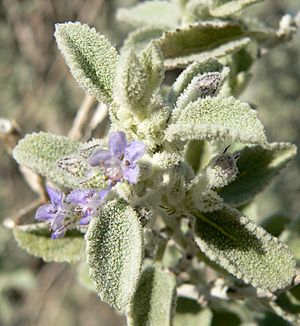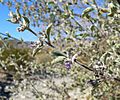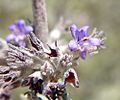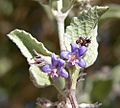Condea emoryi facts for kids
Quick facts for kids Condea emoryi |
|
|---|---|
 |
|
| Condea emoryi–terminal flower | |
| Conservation status | |
| Scientific classification | |
| Genus: |
Condea
|
| Species: |
emoryi
|
The desert lavender (scientific name: Condea emoryi) is a cool shrub that grows in the desert. It used to be called Hyptis emoryi. This plant is part of the Lamiaceae family, which is also known as the mint family.
Desert lavender is a favorite plant for honeybees. They especially love it in the early spring in the deserts of North America.
Contents
What is Desert Lavender?
Desert lavender is a medium to tall shrub. It doesn't like cold weather very much. You can find it in the southwestern United States. This includes places like Arizona, Nevada, and California. It also grows in northwestern Mexico, in Sonora and Baja California.
How Does It Look?
This shrub has many stems and can grow quite tall. It can reach up to 15 to 18 feet (about 4.5 to 5.5 meters) in good spots. Its flowers are a pretty violet-blue color. They can be up to 1 inch (2.5 cm) wide.
The flowers grow all along the main stems and side branches. They have a strong, pleasant smell. This smell attracts honeybees and other insects. The leaves are oval-shaped and a grayish-white color. They have jagged edges and are a bit hairy. Each leaf is about 2 to 3 inches (5 to 7.5 cm) long.
Where Does It Grow?
Desert lavender often grows in dry riverbeds, called washes. It also likes rocky slopes. You can find it at elevations up to 3,000 feet (about 900 meters). This plant can be evergreen, meaning it keeps its leaves all year. Or, it might lose its leaves in the cold, depending on where it lives.
Where Can You Find Desert Lavender?
This plant mostly grows in areas where there is some water. In the deserts of the southwestern US, it's common in dry washes. It often grows alongside other desert plants.
For example, in the Yuma Desert in southwest Arizona, it grows with plants like creosote bush and palo verde. Other plants it shares its home with include Bebbia, Encelia farinosa, and desert ironwood. You might also see it with wolfberry and a type of smoke tree.
In Arizona, you can find it in the central and southwestern parts of the Sonoran Desert. It also grows in parts of the Mojave Desert in northwest Arizona. In southern California and Nevada, desert lavender is found in the southern Mojave Desert and the Colorado Desert.
Images for kids








